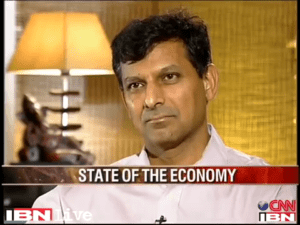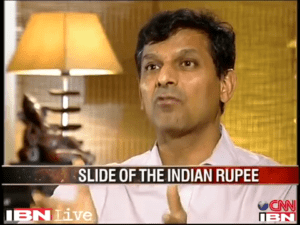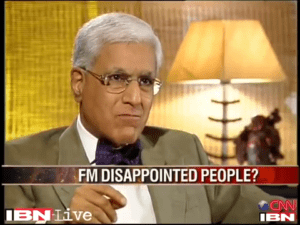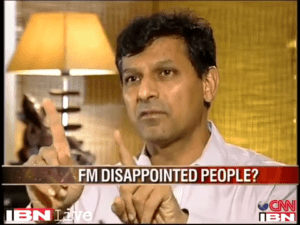Dr. Raghuram Rajan – Body Language Analysis As Chief Economic Advisor
One of the most awaited persons speaking on Indian television includes The Governor of the Reserve Bank of India, since his statements are capable of moving financial markets like none other. I thus decided to listen to our current guv, Dr. Raghuram Rajan, speak about the latest rate hike decision. But before I got the chance to analyse his speech, I chanced upon his latest interview with Karan Thapar on the show The Devil’s Advocate in Jan 2014. I personally believe an interview is the best way to get to know about the body language of a public figure since he would be having a one-on-one conversation with another person. This has more chances of leakages, microexpressions, and unreahearsed body language gestures than a prepared speech.
Incidentally, Raghuram Rajan also appeared on the same talk show in June 2013, at which time he was the Chief Economic Advisor to the ruling party. This was a few months before he moved into the post of the Governor, which was in Sept 2013. This gives us a chance to see if there is any significant shift in his body language cues.
THE JUNE 2013 INTERVIEW
Below is the original interview as aired on IBN Live
Establishing a baseline
Look at the picture of the guest on the talk show Dr. Raghuram Rajan.
This picture shows him with a slight smile on his face, with the lips pointing slightly downwards. Lips pointing downwards could mean disagreement or contempt during an ongoing conversation but this is Rajan’s neutral or normal face since this is the default face of the CEA at the very beginning of the program and whenever he is not reacting or responding to any question put forward by the host. You need to keep the neutral face in mind so that any changes in the face can be noted later on for observing reactions.
OBSERVATIONS
You can broadly observe that both the host and the guest use their arms to highlight their point of view very frequently, which is an effective way of communicating. Here are a few of Rajan’s poses so that you can see what it means to use hand gestures to stress your point.
To dissect the interview and make observations, you would probably need to run and rerun the interview several times. Here are a few observations which I personally found noteworthy. At 1:35 Rajan talks about how other emerging markets currencies have experienced exact the same fall as our market but while saying this he shakes his head rather than nodding. Should we take this as a low confidence indicator meaning Rajan had little confidence in what he was saying or in other words did he believe the fall in the rupee had little to do with how other emerging markets were behaving? Before we jump to this conclusion, we need to remember that there are some gestures which are culture specific. Indians are famous for giving a typical “head bob” with the head going from side to side when they are agreeing to a point rather than nodding up and down. So in this instance, we would have to give Rajan the benefit of the doubt.
At 1:58 you can see Rajan swallowing when he is being further grilled on the fall of the rupee in May. People generally swallow evidently when they are caught in a difficult situation. Clearly, the CEA feels more accountable for the rupee fall than he is letting on.
During the beginning minutes of the interview, you can see Thapar ready with questions, so much so that he appears rather impatient and shows signs wanting to bombard one question after the other, rather than listen to the CEA speaking. The same is not seen in Rajan, who does not show any obvious signs of being harassed by the tough questions. In the below picture you can see Thapar biting his lips to stop himself from speaking, after having made several attempts at interrupting Rajan before he finished his point.
He repeats this action again at 6:28
If the interviewer appears too much in a hurry, the guest might become a little defensive at not being heard out properly. This might affect his answers later on in the show.
Next, a typical look of surprise is seen on Rajan’s face at 5:28
In a typical surprise look, the eyes widen (but there is no narrowing of the lower eyelid), there are creases running parallel on the forehead, and the jaw drops open without any tension at the corners of the lips (Paul Ekman, Unmasking the Face). Perhaps the topic of the FM’s recent press conference was a little unexpected by Rajan or the accusation made by Thapar that the FM did not announce things that the government had done surprised him. He non verbally denies the accusation (shakes his head in disbelief) and then presents his clarification a little later.
Rajan falters for a few seconds before gathering his act but you can see his confidence returning when he highlights two definitive actions announced by the government in the mentioned press conference. Here is the picture at 6:42 where he displays a more authoritative body language.
Thapar further goes on to accuse the government of failing to act and you can see Rajan drawing a deep breath at 7:42, probably bracing himself to further defend the actions of the government. A little further on, he does accept the fact that government processes in India take too long and explains that new structures have been put forward but they will need a little time.
Thapar is not willing to drop the topic of the slowness of the government and you can see Raghuram Rajan’s growing discomfort with the discussion. Rajan starts with a Mouth Cover gesture, using two fingers to cover his lips (usually used to hide what the person might say next, a sign of deceit). He goes on to rub his throat first and then his neck as well. These three signs together form what is called a cluster of gesture display. One cue by itself cannot be used to conclude anything definitively but many gestures complimenting each other form a cluster and can be used to arrive at a conclusion – the CEA is uncomfortable for being held accountable for the inaction on the part of the government. There can be several possibilities.
OTHER TAKEAWAYS
The seating arrangement of the talk show is one of the favoured ones, having the guest sit comfortably on a sofa across from the host. The guest has space to move his hands and feet and can thus be more comfortable in sharing his views. We can compare the same to an across the table interview where the seating arrangement would cause the guest to either put his hands on the table or below the table, thereby restricting his hand movements. This has an impact on people who are used to using their hands to express themselves as it makes them become closed or defensive right from the onset of the interview.
Coming back to the interview in discussion, during the show, Karan uses an effective technique of stressing a point, which is using a curved finger pointing with the index finger joining the thumb to form a circle and using this to point, rather than a single index finger which can look “aggressive, belligerent and rude” (as concluded in an experiment by Body Language Expert Allan Pease and recorded in his book The Definitive Book of Body Language).
MIRRORING TO BUILD RAPPORT
People who start connecting with one another while communicating often imitate each other’s body language, be it hand gestures or feet placement or facial expressions. In this interview, you can see Raghuram Rajan mirroring his host in at least three ways.
Here is the first instance where you can see him using the curved finger like Karan in above picture
Second is the two arm gesture which is used extensively by Karan right from the beginning of the interview. Here is first Thapar and later Rajan captured with this gesture.
There is also the use of timeline reference wherein this two arm gesture shifts to the left of the person when he talks about the past and to his right when he talks about the future. Thapar uses this almost at the beginning of the interview (2:18 is the first one) and Rajan does the same later on. The more the mirroring between two people, the more likely they are to be receptive to each other’s point of view. At most times, mirroring is done subconsciously by people communicating with each other.
TAKEAWAY FROM THE INTERVIEW
On a talk show like the Devil’s Advocate, the intention is to present the guest with tough questions and see if he reacts in an unguarded fashion. From the onset of the interview, Raghuram Rajan appears calm and remains so throughout, reflecting the eminent personality that he is. He was almost always seen using open arm gestural interaction, which generally signals a person’s intention to want to be honest and communicative. But as far as his rapport with the government goes, there is a possibility that it is not of the best of the terms.
Continue to read about body language analysis of Dr. Raghuram Rajan as Governor of RBI
HOW WE CAN HELP
Enhance your teaching impact with our tailored programs focused on improving non-verbal communication. Learn to build stronger connections with students, manage classrooms effectively, and boost student engagement. If you are looking to upgrade your body language skills, check out our online pre recorded courses on various topics that come with lifetime access. You can also explore our Signature Body Language Personal Coaching program Reach out to us on – 99309 41534.






























